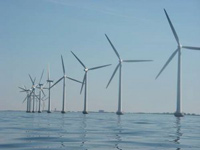 The United States is far behind the countries of Western Europe and China in the development of offshore wind power. Today, Secretary of the Interior Ken Salazar and Secretary of Energy Steven Chu announced a few steps toward catching up.
The United States is far behind the countries of Western Europe and China in the development of offshore wind power. Today, Secretary of the Interior Ken Salazar and Secretary of Energy Steven Chu announced a few steps toward catching up.
Salazar, Chu Announce Major Offshore Wind Initiatives
Unveiling a coordinated strategic plan to accelerate the development of offshore wind energy, Secretary of the Interior Ken Salazar and Secretary of Energy Steven Chu today announced major steps forward in support of offshore wind energy in the United States, including new funding opportunities for up to $50.5 million for projects that support offshore wind energy deployment and several high priority Wind Energy Areas in the mid-Atlantic that will spur rapid, responsible development of this abundant renewable resource.
Deployment of clean, renewable offshore wind energy will help meet the President’s goal of generating 80 percent of the Nation’s electricity from clean energy sources by 2035.
In support of this Strategic Work Plan, Secretary Chu announced today the release of three solicitations, representing up to $50.5 million over 5 years, to develop breakthrough offshore wind energy technology and to reduce specific market barriers to its deployment:
Technology Development (up to $25 million over 5 years): DOE will support the development of innovative wind turbine design tools and hardware to provide the foundation for a cost-competitive and world-class offshore wind industry in the United States. Specific activities will include the development of open-source computational tools, system-optimized offshore wind plant concept studies, and coupled turbine rotor and control systems to optimize next-generation offshore wind systems.
Removing Market Barriers (up to $18 million over 3 years): DOE will support baseline studies and targeted environmental research to characterize key industry sectors and factors limiting the deployment of offshore wind. Specific activities will include offshore wind market and economic analysis; environmental risk reduction; manufacturing and supply chain development; transmission planning and interconnection strategies; optimized infrastructure and operations; and wind resource characterization.
Next-Generation Drivetrain (up to $7.5 million over 3 years): DOE will fund the development and refinement of next-generation designs for wind turbine drivetrains, a core technology required for cost-effective offshore wind power.
Today Salazar also identified four Wind Energy Areas offshore the mid-Atlantic as part of Interior’s ‘Smart from the Start’ approach announced in November 2010 that uses appropriate designated areas, coordinated environmental studies, large-scale planning and expedited approval processes to speed offshore wind energy development. The areas, on the Outer Continental Shelf offshore Delaware (122 square nautical miles), Maryland (207), New Jersey (417), and Virginia (165), will receive early environmental reviews that will help to lessen the time required for review, leasing and approval of offshore wind turbine facilities.
In March, Interior also expects to identify Wind Energy Areas off of North Atlantic states, including Massachusetts and Rhode Island, and launch additional NEPA environmental reviews for those areas. A similar process will occur for South Atlantic region, namely North Carolina, this spring.

“Deployment of clean, renewable offshore wind energy will help meet the President’s goal of generating 80 percent of the Nation’s electricity from clean energy sources by 2035.”
Well technically I guess he is correct but it is like saying spitting into a pool will help fill it up.
Also here is a article that investigates the real environmental cost of those nice “green” wind turbines. A lot of pollution and illness in China to supply the materials for the magnets. Is that really green or is it just shifting the problem to someone elses backyard?
http://www.dailymail.co.uk/home/moslive/article-1350811/In-China-true-cost-Britains-clean-green-wind-power-experiment-Pollution-disastrous-scale.html
Your concerns about Chinese manufacturing are well founded but not directly related to offshore wind power. Sadly the Chinese have demonstrated poor manufacturing practices in everything from children’s’ toys to dog food to wall board. It certainly suggests that Western buyers have a responsibly to monitor Chinese subcontractors to minimize pollution and attempt to guarantee quality control.
Perhaps, some good ol’ yankee entrepreneur will step up to the plate and start( drum roll ) manufacturing what we require here at home.
Sub-contracting things out is why our economy is in the dumper. We used to be leaders, inovators, inventers, builders. Now, it seems the only reliable industries in the U. S. are weapons, and the soldiers who use them. We produce the worlds finest warriors.
I agree with you Bill.
The US, along with many other countries have significant deposits of the required materials that could be mined, processed and used to build the turbines locally rather than the current importing. But in most of those countries the environmental controls that would be required (and should be required, to much land was polluted by the old mining methods) cause locally produced materials to be many times as expensive as importing from China where the environment is ignored and the country side is being systematically destroyed.
We need to require other countries to meet similar environmental restrictions as domestic sources and if they don’t then their products should have a tariff added to allow domestic production to compete on a level playing field.
I am not necessarily an opponent of foreign manufacturing. Trade is reason we all need ships, after all. That being said, these days manufacturers need to supervise all links in the value added chain, whether they are manufacturing shirts in Bangladesh or wind mill components in China.